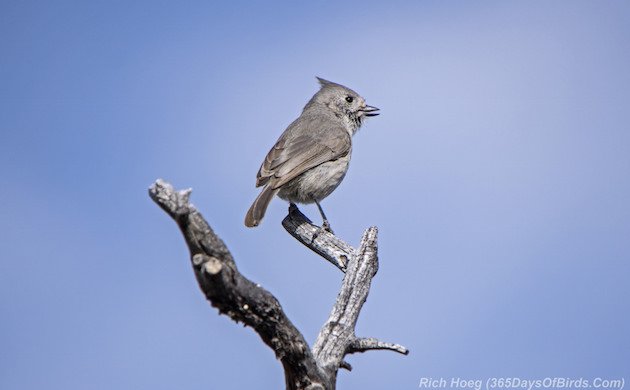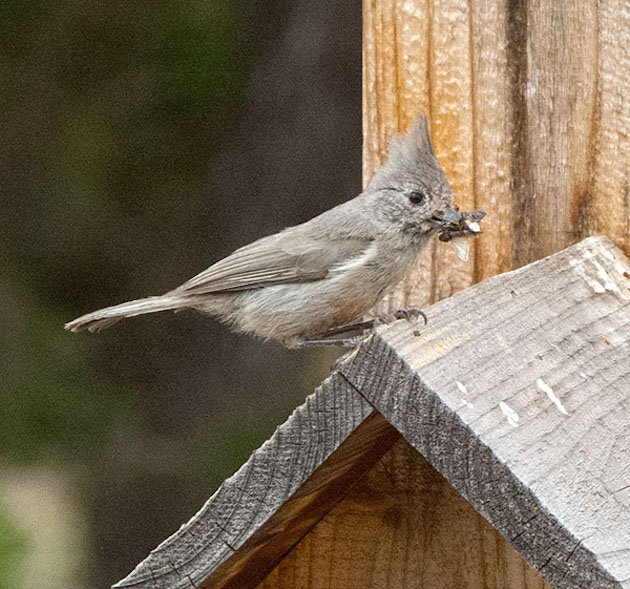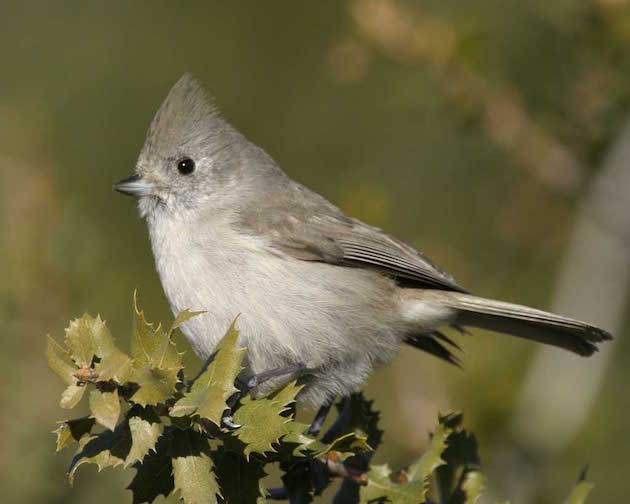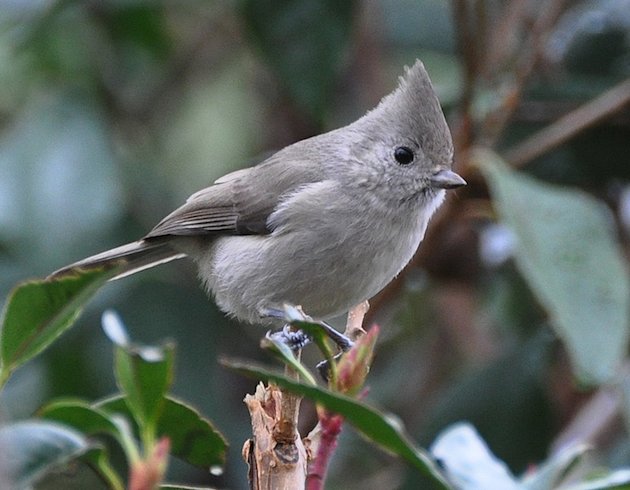
The Juniper Titmouse (Baeolophus ridgwayi) is a passerine bird in the tit family Paridae. The American Ornithologists’ Union split the Plain Titmouse (Parus inornatus) into the Oak Titmouse and the Juniper Titmouse in 1996, due to distinct differences in song, preferred habitat, and genetic makeup. The featured image above is a Creative Commons (CC) photo from Rich Hoeg. You can see the full sized image here. Below is my photo of the Oak Titmouse (Baeolophus inornatus). Click on the photo for a full sized image. You can also see my 10000 Birds post on the Oak Titmouse here.
Thanks to my friend Rebecca Carrier for penning this post for 10,000 Birds on my behalf.
Like many Santa Feans, I live next to a piñon-juniper (PJ) pygmy forest, a fairly dense area of small evergreens in the high-desert. One of my favorite bird species living by my house is the Juniper Titmouse. It’s not flashy – very drab grey, actually – but I like watching its antics. A busy bird, it’s skilled at acrobatics as it reaches for piñon nuts or hops around the trees outside my window. And, like the name implies, it is found mainly in the PJ forests of the six western states that have this type of habitat.
In 2017, my neighborhood, Aldea de Santa Fe, began a Juniper Titmouse Nesting Box Project in collaboration with the Cornell Lab of Ornithology’s NestWatch Program. The Aldea Birding Group that spearheaded this project placed 70 nest boxes in our open spaces and pulled in volunteers to monitor them during the bird’s mating season. Well, as a birder, how can you resist getting involved? I kept an eye on two boxes for several months this year (below Juniper Titmouse (CC) courtesy TJfromAZ’s Flickr page).

Although the Juniper Titmouse is not officially a threatened species, its numbers have been declining due to loss of habitat. Aldea also received a National Wildlife Federation Certified Community Wildlife Habitat designation, so the community’s goal is not only to see how many nesting pairs we can count, but also to improve the habitat. Hopefully, we can increase its numbers through preservation and permaculture, as well as the Mountain Chickadee and Bewick’s Wren, which are also declining.

So, how many chicks hatched in my two boxes? None. But a Bewick’s Wren did build a nest, which it promptly abandoned before laying any eggs. Others had more luck. This year, the community counted nine Bewick’s Wren nests with 36 fledglings; 10 Juniper Titmouse nests with 38 fledglings; and one Mountain Chickadee nest with five fledglings. A total of 79 fledged, which beat our 2017 count of 52. We like to believe the increased numbers are due to our enhancement and preservation of the habitat. But perhaps “tweets” simply went out that Aldea is a great place to raise chicks.
This year, we received the following comment from Robyn Bailey of the Cornell Lab of Ornithology: “The Aldea Bird Group is by far the largest contributor of Juniper Titmouse nesting data that we have (72% of submissions). We at NestWatch are very excited that this group has burst onto the scene and quickly become our primary source of information about this species. In fact, they have risen to become the most active Nest Watching group in New Mexico (regardless of species), contributing 77% of the state’s data in 2018.”
Not bad for our little-known spot on the map. I’ll let you know how it goes next year.












I know we are at the very northern end of this titmouse’s range, but there had been a few reports of them near Hart Mountain NWR. I put in quite a bit of hiking, in hopes of locating one for my years list. No luck. I am heading to New Mexico in about two weeks….maybe I can still check that one off my target list!
Tom, I think you have a pretty good chance to spot the Juniper Titmouse in New Mexico. According to Birds of North America Online, “The species appears to be largely sedentary, with pairs defending territories year-round.” Checking eBird, there seem to be many hot spots where numerous Juniper Titmouse have been seen.
Hi Larry, I am glad I came across your blog, about one of my fav birds! I have some land near Cerrillos, off of Goldmine Road, a great place to hike, relax, and feed the birds. In particular I have been able to befriend a very friendly pair of titmice, and a pair of scrub jays, but unfortunately the jay lost it’s mate a few months ago. The female titmouse, whom we call Missy is exceptionally sweet, trusting and friendly, and lately we have been able to get her to eat unsalted peanuts out of our hand, or on our legs. Her mate, whom we call Sir, comes somewhat close but doesn’t pay us much mind. We have gotten the jay to come to within about 5 feet for peanuts, almonds, raisins, etc, but he or she is more wary. If you send me your Email address i would be glad to send you some fun little videos of Missy eating out of our hand, or next to us,
Have you ever had one that is that friendly?